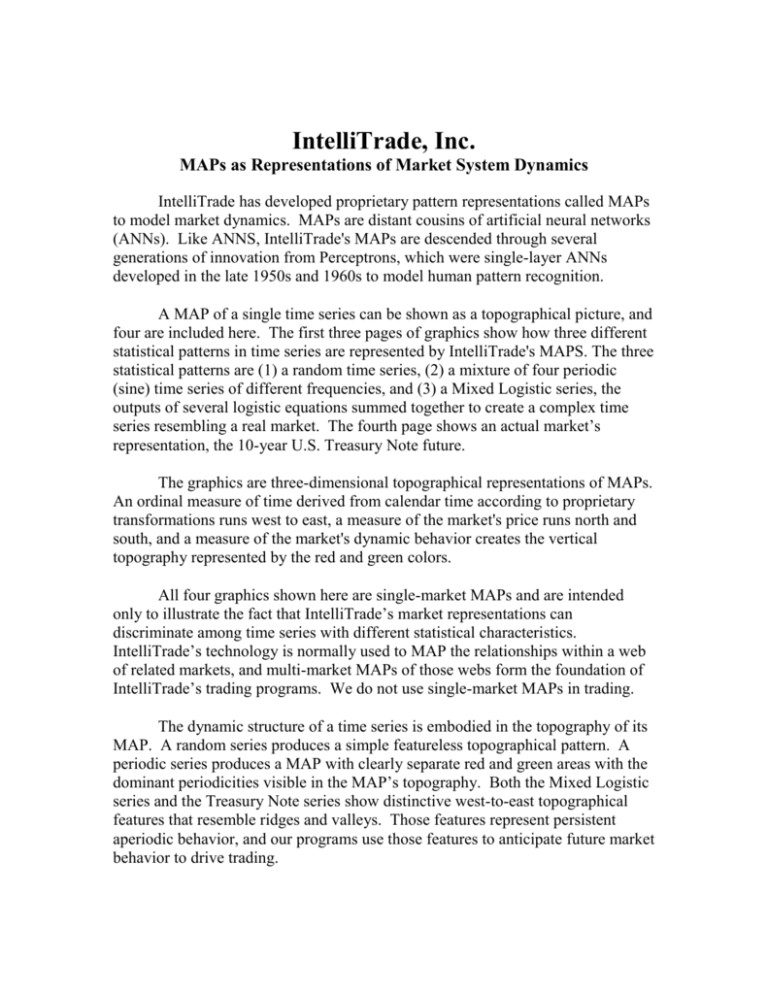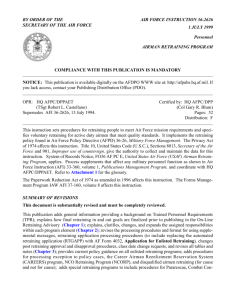MAPs as Representations of Market System Dynamics
advertisement

IntelliTrade, Inc. MAPs as Representations of Market System Dynamics IntelliTrade has developed proprietary pattern representations called MAPs to model market dynamics. MAPs are distant cousins of artificial neural networks (ANNs). Like ANNS, IntelliTrade's MAPs are descended through several generations of innovation from Perceptrons, which were single-layer ANNs developed in the late 1950s and 1960s to model human pattern recognition. A MAP of a single time series can be shown as a topographical picture, and four are included here. The first three pages of graphics show how three different statistical patterns in time series are represented by IntelliTrade's MAPS. The three statistical patterns are (1) a random time series, (2) a mixture of four periodic (sine) time series of different frequencies, and (3) a Mixed Logistic series, the outputs of several logistic equations summed together to create a complex time series resembling a real market. The fourth page shows an actual market’s representation, the 10-year U.S. Treasury Note future. The graphics are three-dimensional topographical representations of MAPs. An ordinal measure of time derived from calendar time according to proprietary transformations runs west to east, a measure of the market's price runs north and south, and a measure of the market's dynamic behavior creates the vertical topography represented by the red and green colors. All four graphics shown here are single-market MAPs and are intended only to illustrate the fact that IntelliTrade’s market representations can discriminate among time series with different statistical characteristics. IntelliTrade’s technology is normally used to MAP the relationships within a web of related markets, and multi-market MAPs of those webs form the foundation of IntelliTrade’s trading programs. We do not use single-market MAPs in trading. The dynamic structure of a time series is embodied in the topography of its MAP. A random series produces a simple featureless topographical pattern. A periodic series produces a MAP with clearly separate red and green areas with the dominant periodicities visible in the MAP’s topography. Both the Mixed Logistic series and the Treasury Note series show distinctive west-to-east topographical features that resemble ridges and valleys. Those features represent persistent aperiodic behavior, and our programs use those features to anticipate future market behavior to drive trading. Random Time Series 106 104 102 100 98 96 94 92 90 1 188 375 562 749 936 1123 1310 1497 1684 1871 2058 2245 2432 MAP of Random Series IntelliTrade, Inc. 2 4 Mixed Sines (Detail) 130 120 110 100 90 80 MAP of 4 Mixed Sine Series IntelliTrade, Inc. 3 Mixed Logistic Time Series MAP of Mixed Logistic Series IntelliTrade, Inc. 4 2401 2201 2001 1801 1601 1401 1201 1001 801 601 401 201 1 110 105 100 95 90 85 80 ` TY Near Month Future Settle 115 110 105 100 95 90 85 80 MAP of 10-Year Note Series IntelliTrade, Inc. 5 Trading the MAPs Our programs extract forecasts from a set of MAPs by comparing the current state and recent past behavior of a market system with the information stored in the MAPs. As noted above, we do not trade on the basis of a singlemarket MAP. Actual markets are embedded in a web of related markets and information from the related markets is necessary to drive reliable trading. Nevertheless, the MAP of a single time series carries information about that series to the extent that internal dynamics drive its behavior. Therefore, FOR ILLUSTRATION ONLY, we used the four MAPs above to ‘trade’ their respective time series, generating cumulative “returns” curves. The trading rules used to trade the four MAPs are the simplest imaginable: For each day, if the current signal from the MAP is above some positive threshold be long; if it is below some negative threshold, be short; else be flat. The results of that ‘trading’ is shown on this graph. The vertical scaling is irrelevant - the data were rescaled to separate pairs of curves so their shapes are visible. There are 2,180 total trading days on the graph, with the last 500 days being Out-of-Sample for all four curves. The first several hundred days of the data series are dropped because the MAPs require them to make an initial forecast. IntelliTrade, Inc. 6 Several features of the cumulative curves are of interest. First, the Random trading shows that our programs can “learn” a random series, but not surprisingly, there is no generalization at all to novel data. The Random cumulative curve goes flat at the transition from Training data to Out-Of-Sample data. A random time series has no internal temporal structure that can be exploited to forecast new data. The fact that a Random series can be learned very well in Training implies that great care must be taken to avoid over-fitting when building MAPs for real markets and that stringent generalization tests are necessary. Second, the 4 Sines curve shows that our programs can learn a complex periodic series very well and that they can use what they have learned to generalize seamlessly to new data. There is no break from Training to Out-OfSample data in the cumulative curve produced by the 4 Sines ‘trading’. If markets were periodic or quasi-periodic, as many technical analysts appear to believe, our MAPs would have no trouble modeling them. However, with interesting exceptions that are associated with strongly seasonal markets, MAPs of actual markets show no periodicities like those visible on the 4 Sines MAP. Third, the Mixed Logistic and actual 10-Year Note (TY) cumulative curves are very similar in their general appearance, with volatility overlaid on a generally upward trend that extends from the Training period through the Out-Of-Sample data. That says that our programs can extract whatever autonomous dynamics there are in a time series and can utilize that information to anticipate likely future behavior in Out-Of-Sample data. Once again, we would not trade the 10-Year Note on this single-market MAP: it is too volatile. Our production trading programs incorporate information from several related markets in order to create more reliable forecasts for trading markets. Nevertheless, the TY cumulative returns curve shows that the MAP has captured information about the autonomous dynamics (“technical” properties) of the 10-Year Note’s price stream, and that information does enter our actual trading programs along with other information. Finally, consistent with what we have learned over a decade of research in modeling markets, there is a subtle indication on the graph suggesting that a fair amount of past data is necessary for the MAPs to learn the dynamical properties of a market price time series. Both the Logistic and TY curves are fairly flat in the first half of the Training period – there is not enough historical information early in training for the MAPs to learn the internal dynamics of the two time series. As training proceeds through time, though, the cumulative curves begin to climb, indicating that with more training data the MAPs come to embody more and more information about the dynamical structure of the time series. That is especially true for the Mixed Logistic series, which is driven solely by internal dynamics. The 10-Year Note is subject to influences from the outside world, and thus its internal dynamics are only part of what drives its price. IntelliTrade, Inc. 7 Adaptation Adaptation is a significant issue in modeling markets. Markets are complex adaptive human social systems. As external conditions change and as market participants learn new behaviors, market dynamics evolve through time rather than remaining static. It is therefore necessary to design market representations that can learn as the markets they represent evolve. Adaptation must occur frequently enough to avoid missing significant changes in the dynamical system, but not so frequently as to ‘adapt’ to transient noise. The rate of adaptation must be appropriate to the time grain(s) of the systems that the program is to model. IntelliTrade’s programs are designed to provide information over time horizons ranging from five to thirty future trading days utilizing from 100 to 300 days of recent past behavior to produce their forecasts. Adaptation in IntelliTrade’s programs occurs mainly through retraining on new data. The MAPs for a given market system or web are originally trained on a fair-sized sample of past history, on the order of five years or more. That training establishes the MAPs’ original “knowledge” of the dynamics a market system has displayed during the training period. Thereafter, MAPs are retrained at intervals of approximately a year. In effect, the retraining overlays new market system behavior on top of an existing MAP, reinforcing recurrences of old dynamic modes and adding information about new modes if they have occurred. One might suppose that feedback of recent forecast error would play a role in determining the frequency of retraining in some markets, but we have found in extensive testing that retraining MAPs at frequent intervals is at best a waste of time and at worst encourages spurious adaptation to transient conditions and/or noise. Absent substantial changes in market system conditions (for example, the 1992 breakdown of the ERM), if a MAP is trained on a sufficiently deep historical sample, retraining is rarely necessary. We have evidence to suggest that the markets we work with display a finite and quite limited number of different dynamical regimes, and once a MAP has learned all of those regimes, retraining is rarely necessary. However, since the events that create substantial changes in market dynamics or that create a new dynamic regime are often known only in hindsight, we retrain and retest our MAPs at least once a year regardless of whether we think a genuinely new dynamical mode has occurred. If changes in market system dynamics have occurred since the last retraining, the MAP will learn the new dynamics; if they have not, it will learn nothing new in retraining and will continue as before. The adaptation issue continues to be an area of active research, though, and our procedures for it may change. IntelliTrade, Inc. 8






